Chenran Li
DexCtrl: Towards Sim-to-Real Dexterity with Adaptive Controller Learning
May 02, 2025


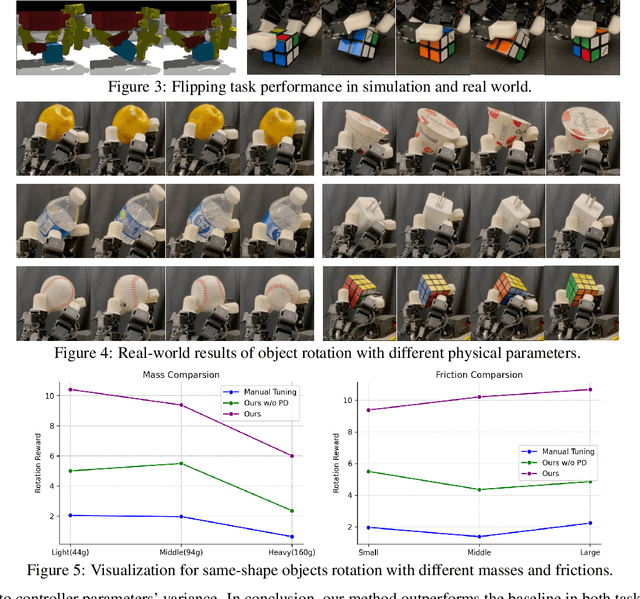
Abstract:Dexterous manipulation has seen remarkable progress in recent years, with policies capable of executing many complex and contact-rich tasks in simulation. However, transferring these policies from simulation to real world remains a significant challenge. One important issue is the mismatch in low-level controller dynamics, where identical trajectories can lead to vastly different contact forces and behaviors when control parameters vary. Existing approaches often rely on manual tuning or controller randomization, which can be labor-intensive, task-specific, and introduce significant training difficulty. In this work, we propose a framework that jointly learns actions and controller parameters based on the historical information of both trajectory and controller. This adaptive controller adjustment mechanism allows the policy to automatically tune control parameters during execution, thereby mitigating the sim-to-real gap without extensive manual tuning or excessive randomization. Moreover, by explicitly providing controller parameters as part of the observation, our approach facilitates better reasoning over force interactions and improves robustness in real-world scenarios. Experimental results demonstrate that our method achieves improved transfer performance across a variety of dexterous tasks involving variable force conditions.
Residual Policy Gradient: A Reward View of KL-regularized Objective
Mar 14, 2025



Abstract:Reinforcement Learning and Imitation Learning have achieved widespread success in many domains but remain constrained during real-world deployment. One of the main issues is the additional requirements that were not considered during training. To address this challenge, policy customization has been introduced, aiming to adapt a prior policy while preserving its inherent properties and meeting new task-specific requirements. A principled approach to policy customization is Residual Q-Learning (RQL), which formulates the problem as a Markov Decision Process (MDP) and derives a family of value-based learning algorithms. However, RQL has not yet been applied to policy gradient methods, which restricts its applicability, especially in tasks where policy gradient has already proven more effective. In this work, we first derive a concise form of Soft Policy Gradient as a preliminary. Building on this, we introduce Residual Policy Gradient (RPG), which extends RQL to policy gradient methods, allowing policy customization in gradient-based RL settings. With the view of RPG, we rethink the KL-regularized objective widely used in RL fine-tuning. We show that under certain assumptions, KL-regularized objective leads to a maximum-entropy policy that balances the inherent properties and task-specific requirements on a reward-level. Our experiments in MuJoCo demonstrate the effectiveness of Soft Policy Gradient and Residual Policy Gradient.
COMPASS: Cross-embodiment Mobility Policy via Residual RL and Skill Synthesis
Feb 22, 2025



Abstract:As robots are increasingly deployed in diverse application domains, generalizable cross-embodiment mobility policies are increasingly essential. While classical mobility stacks have proven effective on specific robot platforms, they pose significant challenges when scaling to new embodiments. Learning-based methods, such as imitation learning (IL) and reinforcement learning (RL), offer alternative solutions but suffer from covariate shift, sparse sampling in large environments, and embodiment-specific constraints. This paper introduces COMPASS, a novel workflow for developing cross-embodiment mobility policies by integrating IL, residual RL, and policy distillation. We begin with IL on a mobile robot, leveraging easily accessible teacher policies to train a foundational model that combines a world model with a mobility policy. Building on this base, we employ residual RL to fine-tune embodiment-specific policies, exploiting pre-trained representations to improve sampling efficiency in handling various physical constraints and sensor modalities. Finally, policy distillation merges these embodiment-specialist policies into a single robust cross-embodiment policy. We empirically demonstrate that COMPASS scales effectively across diverse robot platforms while maintaining adaptability to various environment configurations, achieving a generalist policy with a success rate approximately 5X higher than the pre-trained IL policy. The resulting framework offers an efficient, scalable solution for cross-embodiment mobility, enabling robots with different designs to navigate safely and efficiently in complex scenarios.
Optimal Driver Warning Generation in Dynamic Driving Environment
Nov 09, 2024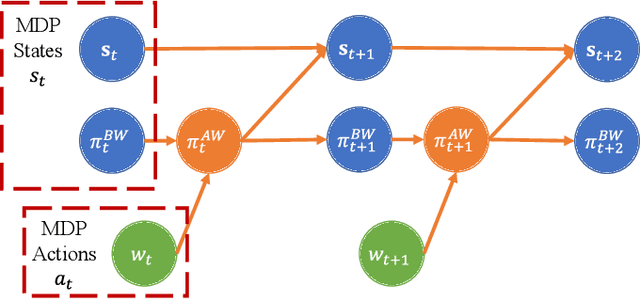
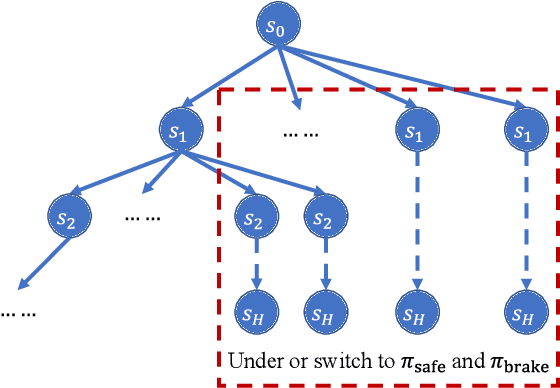
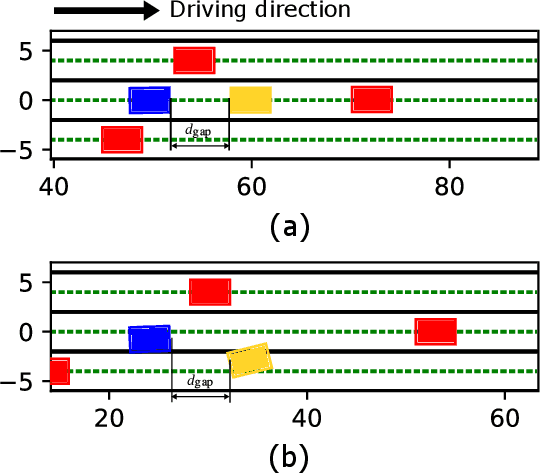
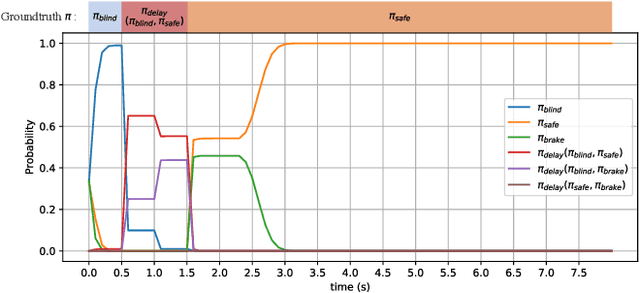
Abstract:The driver warning system that alerts the human driver about potential risks during driving is a key feature of an advanced driver assistance system. Existing driver warning technologies, mainly the forward collision warning and unsafe lane change warning, can reduce the risk of collision caused by human errors. However, the current design methods have several major limitations. Firstly, the warnings are mainly generated in a one-shot manner without modeling the ego driver's reactions and surrounding objects, which reduces the flexibility and generality of the system over different scenarios. Additionally, the triggering conditions of warning are mostly rule-based threshold-checking given the current state, which lacks the prediction of the potential risk in a sufficiently long future horizon. In this work, we study the problem of optimally generating driver warnings by considering the interactions among the generated warning, the driver behavior, and the states of ego and surrounding vehicles on a long horizon. The warning generation problem is formulated as a partially observed Markov decision process (POMDP). An optimal warning generation framework is proposed as a solution to the proposed POMDP. The simulation experiments demonstrate the superiority of the proposed solution to the existing warning generation methods.
DexH2R: Task-oriented Dexterous Manipulation from Human to Robots
Nov 07, 2024Abstract:Dexterous manipulation is a critical aspect of human capability, enabling interaction with a wide variety of objects. Recent advancements in learning from human demonstrations and teleoperation have enabled progress for robots in such ability. However, these approaches either require complex data collection such as costly human effort for eye-robot contact, or suffer from poor generalization when faced with novel scenarios. To solve both challenges, we propose a framework, DexH2R, that combines human hand motion retargeting with a task-oriented residual action policy, improving task performance by bridging the embodiment gap between human and robotic dexterous hands. Specifically, DexH2R learns the residual policy directly from retargeted primitive actions and task-oriented rewards, eliminating the need for labor-intensive teleoperation systems. Moreover, we incorporate test-time guidance for novel scenarios by taking in desired trajectories of human hands and objects, allowing the dexterous hand to acquire new skills with high generalizability. Extensive experiments in both simulation and real-world environments demonstrate the effectiveness of our work, outperforming prior state-of-the-arts by 40% across various settings.
X-MOBILITY: End-To-End Generalizable Navigation via World Modeling
Oct 23, 2024



Abstract:General-purpose navigation in challenging environments remains a significant problem in robotics, with current state-of-the-art approaches facing myriad limitations. Classical approaches struggle with cluttered settings and require extensive tuning, while learning-based methods face difficulties generalizing to out-of-distribution environments. This paper introduces X-Mobility, an end-to-end generalizable navigation model that overcomes existing challenges by leveraging three key ideas. First, X-Mobility employs an auto-regressive world modeling architecture with a latent state space to capture world dynamics. Second, a diverse set of multi-head decoders enables the model to learn a rich state representation that correlates strongly with effective navigation skills. Third, by decoupling world modeling from action policy, our architecture can train effectively on a variety of data sources, both with and without expert policies: off-policy data allows the model to learn world dynamics, while on-policy data with supervisory control enables optimal action policy learning. Through extensive experiments, we demonstrate that X-Mobility not only generalizes effectively but also surpasses current state-of-the-art navigation approaches. Additionally, X-Mobility also achieves zero-shot Sim2Real transferability and shows strong potential for cross-embodiment generalization.
WOMD-Reasoning: A Large-Scale Language Dataset for Interaction and Driving Intentions Reasoning
Jul 05, 2024



Abstract:We propose Waymo Open Motion Dataset-Reasoning (WOMD-Reasoning), a language annotation dataset built on WOMD, with a focus on describing and reasoning interactions and intentions in driving scenarios. Previous language datasets primarily captured interactions caused by close distances. However, interactions induced by traffic rules and human intentions, which can occur over long distances, are yet sufficiently covered, despite being very common and more challenging for prediction or planning models to understand. Therefore, our WOMD-Reasoning focuses extensively on these interactions, providing a total of 409k Q&As for varying types of interactions. Additionally, WOMD-Reasoning presents by far the largest Q&A dataset on real-world driving scenarios, with around 3 million Q&As covering various topics of autonomous driving from map descriptions, motion status descriptions, to narratives and analyses of agents' interactions, behaviors, and intentions. This extensive textual information enables fine-tuning driving-related Large Language Models (LLMs) for a wide range of applications like scene description, prediction, planning, etc. By incorporating interaction and intention language from WOMD-Reasoning, we see significant enhancements in the performance of the state-of-the-art trajectory prediction model, Multipath++, with improvements of 10.14% in $MR_6$ and 6.90% in $minFDE_6$, proving the effectiveness of WOMD-Reasoning. We hope WOMD-Reasoning would empower LLMs in driving to offer better interaction understanding and behavioral reasoning. The dataset is available on https://waymo.com/open/download .
Residual-MPPI: Online Policy Customization for Continuous Control
Jul 02, 2024Abstract:Policies learned through Reinforcement Learning (RL) and Imitation Learning (IL) have demonstrated significant potential in achieving advanced performance in continuous control tasks. However, in real-world environments, it is often necessary to further customize a trained policy when there are additional requirements that were unforeseen during the original training phase. It is possible to fine-tune the policy to meet the new requirements, but this often requires collecting new data with the added requirements and access to the original training metric and policy parameters. In contrast, an online planning algorithm, if capable of meeting the additional requirements, can eliminate the necessity for extensive training phases and customize the policy without knowledge of the original training scheme or task. In this work, we propose a generic online planning algorithm for customizing continuous-control policies at the execution time which we call Residual-MPPI. It is able to customize a given prior policy on new performance metrics in few-shot and even zero-shot online settings. Also, Residual-MPPI only requires access to the action distribution produced by the prior policy, without additional knowledge regarding the original task. Through our experiments, we demonstrate that the proposed Residual-MPPI algorithm can accomplish the few-shot/zero-shot online policy customization task effectively, including customizing the champion-level racing agent, Gran Turismo Sophy (GT Sophy) 1.0, in the challenging car racing scenario, Gran Turismo Sport (GTS) environment. Demo videos are available on our website: https://sites.google.com/view/residual-mppi
MEReQ: Max-Ent Residual-Q Inverse RL for Sample-Efficient Alignment from Intervention
Jun 24, 2024Abstract:Aligning robot behavior with human preferences is crucial for deploying embodied AI agents in human-centered environments. A promising solution is interactive imitation learning from human intervention, where a human expert observes the policy's execution and provides interventions as feedback. However, existing methods often fail to utilize the prior policy efficiently to facilitate learning, thus hindering sample efficiency. In this work, we introduce MEReQ (Maximum-Entropy Residual-Q Inverse Reinforcement Learning), designed for sample-efficient alignment from human intervention. Instead of inferring the complete human behavior characteristics, MEReQ infers a residual reward function that captures the discrepancy between the human expert's and the prior policy's underlying reward functions. It then employs Residual Q-Learning (RQL) to align the policy with human preferences using this residual reward function. Extensive evaluations on simulated and real-world tasks demonstrate that MEReQ achieves sample-efficient policy alignment from human intervention.
Adaptive Energy Regularization for Autonomous Gait Transition and Energy-Efficient Quadruped Locomotion
Mar 29, 2024



Abstract:In reinforcement learning for legged robot locomotion, crafting effective reward strategies is crucial. Pre-defined gait patterns and complex reward systems are widely used to stabilize policy training. Drawing from the natural locomotion behaviors of humans and animals, which adapt their gaits to minimize energy consumption, we propose a simplified, energy-centric reward strategy to foster the development of energy-efficient locomotion across various speeds in quadruped robots. By implementing an adaptive energy reward function and adjusting the weights based on velocity, we demonstrate that our approach enables ANYmal-C and Unitree Go1 robots to autonomously select appropriate gaits, such as four-beat walking at lower speeds and trotting at higher speeds, resulting in improved energy efficiency and stable velocity tracking compared to previous methods using complex reward designs and prior gait knowledge. The effectiveness of our policy is validated through simulations in the IsaacGym simulation environment and on real robots, demonstrating its potential to facilitate stable and adaptive locomotion.
 Add to Chrome
Add to Chrome Add to Firefox
Add to Firefox Add to Edge
Add to Edge